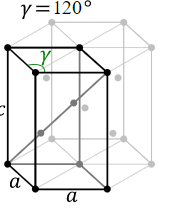
The hcp and ccp structures for a given element would be expected to have:
(A) Same coordinator number
(B) Same density if made up of small element
(C) Same packing fraction
(D) Same number of atoms in single unit cell
Answer
574.5k+ views
Hint: The ordered structure that has occurred from the intrinsic nature of the constituent particles or atoms to form symmetric patterns of the crystal structure that repeat along all the dimensions are known as unit cells.
Complete step by step answer:
In a Hexagonal close packed structure (hcp) the third layer of the atoms has the same arrangement as per the spheres of the first layer while the second layer covers are different. Thus, it can be represented as ‘ababab…’ The spheres or atoms of the third layer covers all the octahedral holes.

Diagram showing HCP structure
Whereas, in the cubic close packed (ccp) structure, the second & the third layer is used to cover the depressions of first and second layer respectively. As all these three layers are completely different from each other thus it can be represented as ‘ABC ABC…’.
Coordination number is used to represent the number of atoms that touch a particular atom. Both the hcp & ccp structures have a coordination number of $\left( {\alpha ,\beta ,\gamma } \right)$ $12$.
The hcp and ccp structure cannot have the same density even if they both are made up of the same element because both these structures have different numbers of atoms per unit cell. The hcp structure has $8$ spheres per unit cell whereas the ccp structure has $4$ spheres per unit cell.
Both the hcp & ccp structures have a packing efficiency of $74$ percent. Thus, the packing fraction would also be the same i.e. both the structures have the packing fraction of $0.74$.
As we know that the hcp and ccp structure has $8$ and $4$ atoms per unit cell respectively. Therefore, this option is not true.
Hence, the answer is option (A) and option (C).
Note:
The Geometry of the unit cell is defined as the parallelepiped, which give us the six lattice parameters that are the lengths of the edges of the cell (a, b, c), i.e. the length, breadth and height and the angles $\left( {\alpha ,\beta ,\gamma } \right)$ between these lengths.
Complete step by step answer:
In a Hexagonal close packed structure (hcp) the third layer of the atoms has the same arrangement as per the spheres of the first layer while the second layer covers are different. Thus, it can be represented as ‘ababab…’ The spheres or atoms of the third layer covers all the octahedral holes.

Diagram showing HCP structure
Whereas, in the cubic close packed (ccp) structure, the second & the third layer is used to cover the depressions of first and second layer respectively. As all these three layers are completely different from each other thus it can be represented as ‘ABC ABC…’.
Coordination number is used to represent the number of atoms that touch a particular atom. Both the hcp & ccp structures have a coordination number of $\left( {\alpha ,\beta ,\gamma } \right)$ $12$.
The hcp and ccp structure cannot have the same density even if they both are made up of the same element because both these structures have different numbers of atoms per unit cell. The hcp structure has $8$ spheres per unit cell whereas the ccp structure has $4$ spheres per unit cell.
Both the hcp & ccp structures have a packing efficiency of $74$ percent. Thus, the packing fraction would also be the same i.e. both the structures have the packing fraction of $0.74$.
As we know that the hcp and ccp structure has $8$ and $4$ atoms per unit cell respectively. Therefore, this option is not true.
Hence, the answer is option (A) and option (C).
Note:
The Geometry of the unit cell is defined as the parallelepiped, which give us the six lattice parameters that are the lengths of the edges of the cell (a, b, c), i.e. the length, breadth and height and the angles $\left( {\alpha ,\beta ,\gamma } \right)$ between these lengths.
Recently Updated Pages
A man running at a speed 5 ms is viewed in the side class 12 physics CBSE

The number of solutions in x in 02pi for which sqrt class 12 maths CBSE

State and explain Hardy Weinbergs Principle class 12 biology CBSE

Write any two methods of preparation of phenol Give class 12 chemistry CBSE

Which of the following statements is wrong a Amnion class 12 biology CBSE

Differentiate between action potential and resting class 12 biology CBSE

Trending doubts
What are the major means of transport Explain each class 12 social science CBSE

Which are the Top 10 Largest Countries of the World?

Draw a labelled sketch of the human eye class 12 physics CBSE

How much time does it take to bleed after eating p class 12 biology CBSE

Explain sex determination in humans with line diag class 12 biology CBSE

Explain sex determination in humans with the help of class 12 biology CBSE




